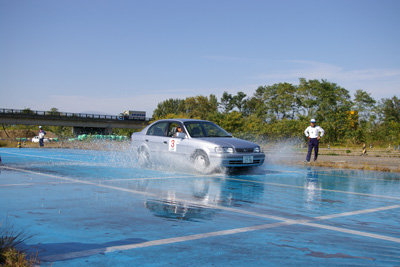April 24, 2006
The JAMA & JAF 2006 Senior Drivers’ and Safe-Driving Programs
Will Take Place at 65 Locations Nationwide, from Hokkaido to Kyushu
One-Day, Hands-On Programs Teach Skills to Help Reduce Traffic Accident Occurrence
The Japan Automobile Manufacturers Association (JAMA), the Japan Automobile Federation (JAF) and the Japan Traffic Safety Association—with key support from the National Police Agency, individual prefectural police headquarters, prefectural traffic safety associations and other organizations—are once again this year jointly sponsoring the “JAMA & JAF Senior Drivers’ Program” and the “JAMA & JAF Safe-Driving Program” throughout Japan. Drivers who have held a driver’s license for at least one year are eligible to enroll in these one-day sessions that train participants in practical safe-driving skills so that they may be better prepared to prevent accident occurrence.
Road Accidents in 2005: More Accidents Involving Elderly Persons
Road fatalities in Japan in 2005 totalled 6,871 — 487 fewer than in the previous year and the first drop below 7,000 since 1956. The roughly 930,000 road accidents represented a decrease of 1.9% from 2004, while the number of accident-related injuries was also down, by 2.2%, to a total of 1.16 million, marking the first year-on-year decline in both these categories in three years.
Road fatalities involving “senior citizens” (65 years or older) totalled 2,924, or 122 fewer than in 2004, but the share of elderly persons in total road fatalities rose to 42.6%, up 1.2% from the previous year. Meanwhile, the number of drivers’ license holders aged 65 or older rose by about 500,000 persons to just under a total of 9.77 million drivers, according to the National Police Agency. Hand in hand with this growing presence of elderly drivers on the road is the rising number of accidents resulting in injury or death that are caused by drivers in this age group — particularly rear-end collisions and collisions occurring when attempting a right turn against oncoming traffic. In 2005 there were a total of 104,455 such accidents, or 3,525 more than in the year before.
In its June 2006 publication titled On the Road to Sustainable Mobility, JAMA outlined its road safety activities for the coming decade, focusing on eight priority areas including special measures for the elderly. As part of these activities, the implementation of the JAMA and JAF-sponsored senior drivers’ and safe-driving programs aim to improve driving skills to help prevent the occurrence of road accidents. The sponsors, meanwhile, plan to further develop the content of these programs and expand the number of venues and the frequency at which they are held, as well as the number of persons participating in them.
Overview of the JAMA & JAF Senior Drivers’ Program:
The Senior Drivers’ Program was launched in 1996 to enable elderly drivers to become more aware of their own driving habits and limitations and thereby to foster safe-driving practices. Designed for drivers aged 65 or older but open to drivers who are at least 50, the program boasts a cumulative participation, in a total of 150 locations, of 3,440 persons, many of whom reported that the experience prompted them to rethink their own driving habits. Comments by participants expressed surprise at how slow their reactions had become, and the realization that they had grown overconfident about their own driving skills.
The program’s content covers vehicle safety checks, driving posture, blind spots, air bag deployment, braking on slippery surfaces, right-hand turns at intersections, crossing intersections in poor visibility, and so on. Hands-on sessions are followed up with question-and-answer periods between participants and instructors.
The 2006 Senior Drivers’ Program will be conducted in 28 locations from Hokkaido to Kyushu, with the inaugural session to be held on May 3 (Wed, holiday) in Kyoto Prefecture.
Overview of the JAMA & JAF Safe-Driving Program:
First held in 1991, the Safe-Driving Program is open to any driver holding a license for at least one year, regardless of age, and is designed so as to enable drivers to advance their understanding of vehicle characteristics, performance limits and other factors, in order to improve their safe-driving skills. In a larger sense, the program also seeks to promote a wide awareness of the need for improved safe-driving practices. By the end of 2005, the program had been held in a total of 282 locations with the participation of about 7,800 persons, one of whom commented that the program was very helpful in making him aware of his faulty driving habits and that he was looking forward to putting his new knowledge into immediate practice.
Program content begins with confirmation of driving basics, then moves on to driving on straight and curved roads, sudden braking, cornering, and many of the practical aspects of driving that are also covered by the Senior Drivers’ Program, thus providing participants with valuable pointers on how to react to and deal with real-life road situations.
The 2006 Safe-Driving Program will be conducted in 37 locations from Hokkaido to Kyushu, kicking off on May 20 (Sat) in Wakayama Prefecture.
Photo: A JAMA & JAF Senior Drivers’ Program session held in fiscal 2005

Practical experience in driving on a slippery road surface covered with water.
